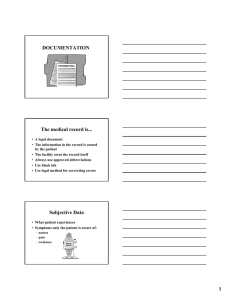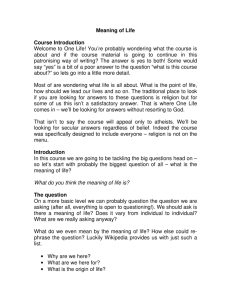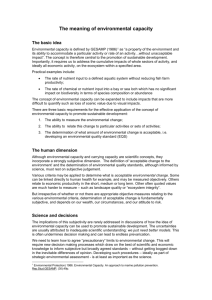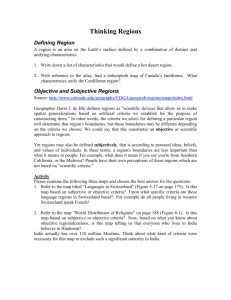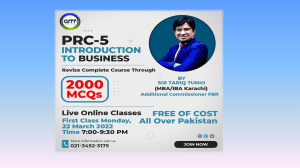A Framework for Taxation-Based Computer Decision Systems
advertisement
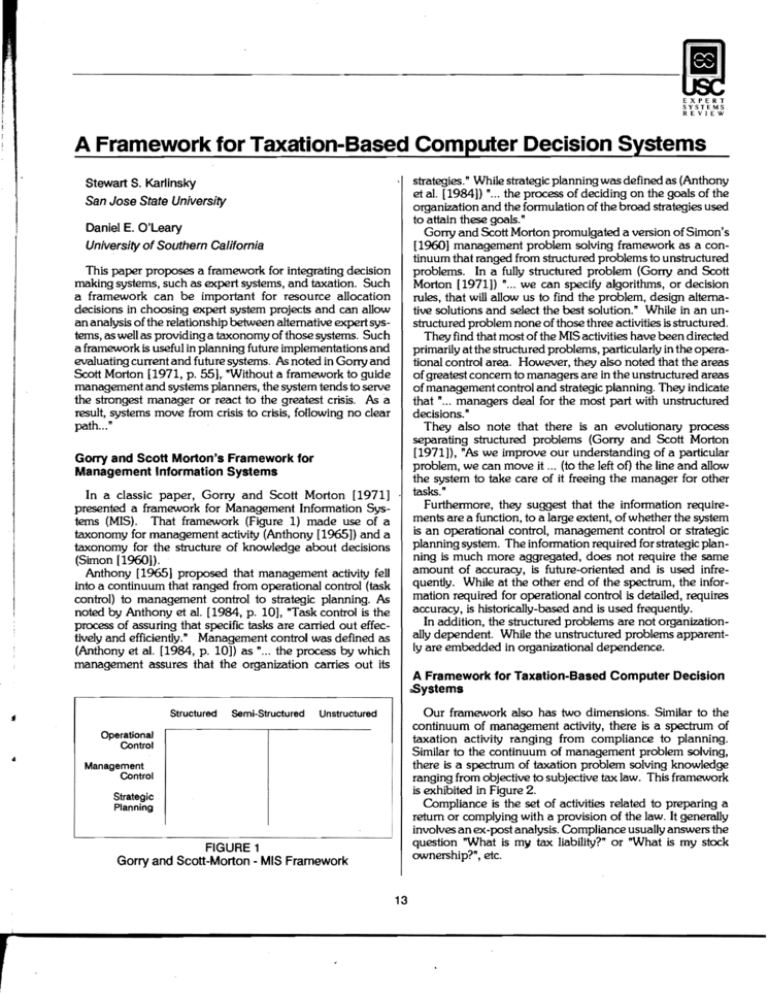
r
----------------1
EXPERT
SYSTEMS
REVIEW
A Framework for Taxation-Based Computer Decision Systems
strategies." While strategic planning was defined as (Anthony
et al. [1984]) "... the process of deciding on the goals of the
organization and the formulation of the broad strategies used
to attain these goals. •
Gorry and Scott Morton promulgated a version of Simon's
[19601 management problem solving framework as a con­
tinuum that ranged from structured problems to unstructured
problems. In a fully structured problem (Gorry and Scott
Morton [1971]) •... we can specify algorithms, or decision
rules, that will allow us to find the problem, design alterna­
tive solutions and select the best solution." While in an un­
structured problem none of those three activities is structured.
They find that most of the MIS activities have been directed
primarily atthe structured problems, particularly in the opera­
tional control area. However, they also noted that the areas
of greatest concern to managers are in the unstructured areas
of management control and strategic planning. They indicate
that •... managers deal for the most part with unstructured
decisions.·
They also note that there is an evolutionary process
separating structured problems (Gorry and Scott Morton
[1971]), "As we improve our understanding of a particular
problem, we can move it ... (to the left of) the line and allow
the system to take care of it freeing the manager for other
tasks."
Furthermore, they suggest that the information require­
ments are a function, to a large extent, of whether the system
is an operational control, management control or strategic
planning system. The information required for strategic plan­
ning is much more aggregated, does not require the same
amount of accuracy, is future-oriented and is used infre­
quently. While at the other end of the spectrum, the infor­
mation required for operational control is detailed, requires
accuracy, is historically-based and is used frequently.
In addition, the structured problems are not organization­
ally dependent. While the unstructured problems apparent­
ly are embedded in organizational dependence.
Stewart S. Karlinsky
San Jose State University
Daniel E. O'Leary
University of Southern California
This paper proposes a framework for integrating decision
making systems, such as expert systems, and taxation. Such
a framework can be important for resource allocation
decisions in choosing expert system projects and can allow
an analysis of the relationship between alternative expert sys­
tems, as well as providing a taxonomy of those systems. Such
a framework is useful in planning future implementations and
evaluating current and future systems. As noted in Gorry and
Scott Morton [1971, p. 551,· "Without a framework to guide
management and systems planners, the system tends to serve
the strongest manager or react to the greatest crisis. As a
result, systems move from crisis to crisis, follOWing no clear
path... "
Gorry and Scott Morton's Framework for
Management Information Systems
In a classic paper, Gorry and Scott Morton [1971]
presented a framework for Management Information Sys­
tems (MIS). That framework (Figure 1) made use of a
taxonomy for management activity (Anthony [1965]) and a
taxonomy for the structure of knowledge about decisions
(Simon [1960]).
Anthony [19651 proposed that management activity fell
into a continuum that ranged from operational control (task
control) to management control to strategic planning. As
noted by Anthony et al. [1984, p. 10], "Task control is the
process of assuring that specific tasks are carried out effec­
tively and efficiently. It Management control was defined as
(Anthony et al. [1984, p. 10]) as "... the process by which
management assures that the organization carries out its
A Framework for Taxation-Based Computer Decision
cSystems
Structured
Semi-Structured
Our framework also has two dimensiOns. Similar to the
continuum of management activity, there is a spectrum of
taxation activity ranging from compliance to planning.
Similar to the continuum of management problem solving,
there is a spectrum of taxation problem solving knowledge
ranging from objective to subjective tax law. This framework
is exhibited in Figure 2.
Compliance is the set of activities related to preparing a
return or complying with a provision of the law. It generally
involves an ex-post analysis. Compliance usually answers the
question "What is my tax liability?" or "What is my stock
ownership?·, etc.
Unstructured
Operational Control Management Control Strategic Planning FIGURE 1
Gorry and Scott-Morton - MIS Framework
13
1------­
EXPERT SYSTEMS REVIEW Planning is the set of activities related to structuring an
event in order to attain a tax goaJ(s). It generally involves an
ex-ante analysis. Planning usually answers questions such as
"How do I minimize my tax liability?" or "How do I reduce
my constructive stock ownership?", etc.
Much of the law can be characterized according to "If ...
(condition) Then ... (consequence)" statements (e.g., Water­
man and Petersen [1981]). If the condition and the conse­
quence are well-defined then the transaction is at the objec­
tive end of the continuum. If the condition and/or conse­
quence are not well-defined then the transaction is at the sub­
jective end of the continuum. Continuing from the objective
to the subjective might also be viewed as follOWing a progres­
sion of statutory law to case law to ex~rt' s heuristics.
In particular, we define objective tax law as a tax provision
that is well-defined by the code and regulation, or well-set­
tled court cases. Whereas, subjective tax law is less well­
defined and usually requires more court case analysis to ar­
rive at the law's determination. For example, Section
302{b)(2) has very dear and ~ific rules that must be met
in order for the transaction to be classified as a redemption.
On the other hand, Section 302(b){1), Section 385 or the
notion of "reasonable compensation" require significant
analysis to determine the status of an activity and, therefore,
are much more subjective in nature.
The primary tax information systems have been develo~d
for the objective - compliance corner of the framework. For
example, there are substantial resources devoted to the com­
puterization of tax returns. large companies, such as Com­
putax and Fasttax, have developed a large base of computer
programs to ~rform these activities. However, there are few
decision making tools available for the subjective - planning
portion of the framework. Instead, highly paid tax ex~rts
perform the activities in these areas.
As with the type of management activity, whether it is plan­
ning or compliance can have a major impact on information
requirements. Compliance requires exact, detailed and his­
torical information with each use of the system. Alternative­
ly, planning requires less accurate, estimated information.
In addition, as with the nature of the problem, whether ob­
jective or subjective Jaw also requires more situation specific
information. With objective law, the same information is re­
quired for each situation. In a truly objective law situation
the level of ex~rtise is not critical -- the same law should be
applied routinely. However, with subjective law, the infor­
mation required is d~ndent on how the problem is struc­
tured and presented. With subjective law-based issues, it
pays to consult with the true ~rt.
LAW
OBJECTIVE
Statutory Law
SUBJECTIVE
Expert's Heuristics
Case Law
Compliance
TASK
Planning
FIGURE 2 Decision Making and Taxation - Framework second case, the knowledge may be accessible directly from
the tax code. In addition, it is more highly likely that a sys­
tem actually can be built and implemented if the problem is
on the objective side of the framework. On the objective side,
. it may be easier to specify objectives, gather knowledge,
. evaluate the system, etc. Alternatively, the greater benefit
may come from applications on the subjective side. From a
research ~rspective, the interesting questions generally are
on the subjective side and come from trying to structure the
problems for implementation in an ~rt system format or
deciding how to elicit knowledge for their solution.
A number oftax ex~rt systems are summarized in Michael­
sen and Messier [1987] and Brown and Streit [1988]. Figure
3 summarizes how some selected ex~rt systems might be
categorized according to our framework.
ExperTAX
ExperTAX was developed by Coopers and Lybrand
(Shpilberg and Graham [1986] and Shpilberg [1986]) to as­
sist their audit staff in analyzing and computing the provision
for income taxes. Ex~rTAX incorporates over 1000 rules
and several hundred frames In order to facilitate analysis by
inex~rlenced audit ~rsonnel. It was developed and imple­
mented in USP, using a forward chaining inference engine.
To educate and keep the user motivated, Ex~rTAX uses a
LAW
Objective
Compliance
ExperTAX
Taxman
TASK
Integrating Previous Work and the Framework
Planning
The framework can be used to analyze existing ex~rt sys­
tems. The systems that likely are the most difficult to solicit
knowledge for are in the planning - subjective area, while the
systems that are the easiest to solicit knowledge for are in the
compliance - objective area. This is because in the first case
the knowledge only is available from the ex~rt, while In the
318(a)
302(b)
Subjective
Taxadvisor
r;:IGURE 3
Decision Making and Taxation - Applications
14
EXPERT
SYSTEMS
REVIEW
1
J
smart questionnaire fonnat and allows feedback to the user
on the rationale for the importance ofsystem generated ques­
tions.
ExperTAX generally does not employ well-defined objec­
tive law but instead integrates various accounting/tax rules
and interpretations. Accordingly, it is towards the subjective
end of the spectrum. The system is considered compliance
oriented since it generates the appropriate deferred income
tax numbers. If the system indicated how to attain a target
earnings per share, then it would be classified as towards the
planning end of the continuum.
tion 318(a) attribute rules. Thus it is more sophisticated than
the Scholbohm program. However, the program incor­
porates little expert judgement, so there also is some ques­
tion as to whether this system is an expert system.
302(b)(2) maps well-defined "If ... Then ... " statements of
the law into computer program and, thus is categorized at the
objective end of the spectrum. In addition, this program in­
cludes the 318(a) infonnation. If this program suggested djf­
ferent ownership or different sale or disposition of stock ac­
tivity, then it would be moved toward the planning end of
the continuum.
TAXADVISOR
TAXMAN
TAXADVISOR was developed by Michaelsen [1982-a,
1982-b, and 1984] to assist in estate tax planning. TAXAD­
VISOR has 275 rules (Michaelsen and Michie [1983]). Be­
cause it is aimed at assisting the experience tax professional
user, the system does not use a smart questionnaire. Al­
though TAXADVISOR proVides a trace of the rules used to
detennine the objective, it does not provide feedback on why
a particular question is asked. The system was developed
using the ES shell, EMYCIN, using a backward chaining in­
ference engine. Since the system uses backward chaining,
multiple solutions are generated. Unfortunately, the system
does not evaluate the options it develops.
TAXADVISOR integrates various expert heuristics where
the conditions produce multiple consequences. Therefore, it
is categorized towards the subjective end of the spectrum.
Since TAXADVISOR is designed to reduce the estate tax
liability, rather than to detennine or compute it, we charac­
terize it as at the planning end of the continuum.
TAXMAN was developed by McCarty [1977 and 1981]
(See also Miller [1984] and McCarty and Sridharan [1980]) .
to assist in analyzing a transaction in relation to court cases
and certain corporate reorganizations. TAXMAN is written
in USP and uses backward chaining. The system analyzes
court cases in the reorganization area to detennine which fac­
tors will allow the user to reach a desired tax consequence.
TAXMAN integrates court case decisions into the
knowledge base, and accordingly is at the subjective end of
the spectrum. To the extent that TAXMAN analyzes the con­
sequences of a reorganization transaction it has elements of
compliance. On the other hand, to the extent that the sys­
tem can be used to structure the transaction, it has elements
of planning.
Section 318(a)
Schlobohm [1984 and 1985] developed a computer
program to analyze the IRC Section 318(a) family attribution
rules. The program is the first application of Prolog to taxa­
tion. It is a rule-based system that directly models the "If ...
Then ... " structure of an objective tax provision. The system
has a limited user interface to generate the data required.
There is some question as to whether this is an "expert sys­
tem," since there is little expert judgement built into the modeL
318(a) literally maps well-defined "If... Then ... " statements
of the law into a computer program and, accordingly, is
categorized in our framework at the objective end of the
spectrum. 318(a) is considered heavily compliance related
because it only detennines if the conditions of the law are
met and is done on an ex-post basis. If the program sug­
gested alternative means of stock ownership then it would be
moved toward the planning end of the continuum.
Section 302(b)
Hellawell [1980] developed a computer program to
analyze the IRC Section 302(b)(2). It is written in the proce­
dural language, BASIC. This program incorporates the sec-
Summary
The development of a tax-based expert system can absorb
a substantial amount of resources. However, there is limited
perspective on the area of tax-based expert systems and the
corresponding design, development and implementation is­
sues. The framework developed in this paper can proVide
one perspective on those issues.
The framework was based based directly on Gorry and
Scott Morton's [1971] framework for management infonna­
tion systems. The framework included two dimensions: Task
(Compliance -- Planning) and Law (Objective to Subjective).
Some expert systems were examined in light of the proposed
framework.
..
Acknowledgement
The authors would like to acknowledge the comments of
the referees. However, any limitations are due to the authors.
REFERENCES
Anthony, R.N., Planning and Control Systems: A
Framework/or Analysis, Harvard University Press, Bos­
ton, 1%5.
Brown, C. and Streit, I. J<., "ASurvey of Tax Expert Systems, It
Expert Systems ReView, (this issue), 1988.
15 EXPERT
SYSTEMS
REVIEW
Gorty, GA and Scott Morton, M.S., "A Framework for
Management Information Systems," Sioon Management
Review, Vol. 13, no. 1, pp. 55-70,1971.
Hellawell, R, "A Computer Program for Legal Planning and
Analysis: Taxation for Stock Redemptions," Columbia
Law Review, Vol. 80, No.7, November, 1980, pp. 1363­
1398.
Keen, P. and Scott Morton, M., Decision Support Systems,
Addison Wesley, Reading, MA, 1978.
MacRae, C.D., "User Control Knowledge in a Tax Consult­
ing System," 2nd International Conference on Com­
puters and Law, Houston, Texas, June, 1985.
MacRae, C.D., "Tax Problem Solving With An If-Then Sys­
tem," in Computing Power and Legal Reasoning, West
Publishing Co., St. Paul, Minnesota, 1985.
McCarty, L.T., "Reflections on TAXMAN:An Experiment in
Artificial Intelligence and legal Reasoning," Harvard Law
Review, Vol. 90, No.5, March, 1977.
McCarty, L.T., "The TAXMAN Project: Towards a Cognitive
Theory of Legal Argument," in B. Niblett (ed.) Computer
Logic and Legal Language, Cambridge Press, 1981.
McCarty, L.T. and Sridharan, N.S., "The Representation of
an EvolVing System of Legal Concepts," Proceedings of
the Third National Conference of the Canadian Society
for Computational Studies of Intelligence, Victoria,
British Columbia, 1980.
Michaelsen, R , "Application of An Expert Computer System
to Federal Tax Planning," ACM-SIGART Newsletter,
No. 82, October, 1982-a.
Michaelsen, R, A Knowledge-Based System for Individual
Income and Transfer Tax Planning, Unpublished Ph. D.
Dissertation, 1982-b.
Michaelsen, R, "An Expert System for Federal Tax Plan­
ning," Expert Systems, Vol. 1, No.2, 1984.
Michaelsen, R and Messier, W., "Expert Systems in Taxa­
tion," Journal of the American Taxation AsSOCiation,
Spring 1987, pp. 7-21.
Michaelsen, R. and Mitchie, D., "Expert Systems in BUSiness,'
Datamation, Vol. 29, November, 1983.
Schlobohm, DA, "The Section 318(a) Program which
Answers How, Help and Why," A sample program in the
software, Prolog 86, 1984.
Schlobohm, DA, "A Prolog Program Which Analyzes In­
come Tax Issues Under Section 318(a) of the Internal
Revenue Code; in C. Walter (ed), Computing Power
and Legal Reasoning, West Publishing, St. Paul, Min­
nesota, 1985.
ShpUberg, D., "ExperTAX: An Expert System for Corporate
Tax Planning, Unpublished paper to be presented at the
Second International Expert Systems Conference and
Exhibition, London, September 30,1986.
Shpilberg, D. and Graham, L., "Developing ExperTAX: An
Expert System for Corporate Tax Accrual and Planning,'
Unpublished paper presented at the University of
Southern California Symposium on Expert Systems,
Los Angeles, Ca., 1986.
Simon, HA, The New Science of Management DeCision,
Harper and Row, New York, 1960.
Seen Elsewhere A recent article in Chain Store Executive (April 1988) dis­
cussed the use of artificial intelligence at Mrs. Fields' Cookies.
Two applications were discussed. The first is used at the
operations level and the second is embedded in the account­
ing systems.
The system is based on the expertise of Debbi Fields, the
founder of Mrs. Fields'. The system provides store managers
with both cost control information and with sales manage­
ment approaches. Thus, the system eliminates much of the
necessary store manager training.
Operations Level
Accounting Systems
Mrs. Fields' store managers start the day by providing an
expert system with information about the day of the week,
the existence of a special sale and whether or not it is a
holiday. The system provides, as output, how many of what
kinds of cookies to sell, in 15 minute increments. It also
provides the operator with information on how much batter
will be required, whether or not more help will be needed and
when those additional personnel will work.
Then, each hour the system is updated based on what has
actually occurred. If sales are below expectations, then the
system may suggest some extra selling techniques or it will
adjust the possible sales figures downward. If sales are above
expectations, then the system will increase its estimates.
Mrs. Fields' has begun to test a system that" ... will receive
invoices through electronic data interchange with a vendor's
computer, use a price look-up database to see if the invoice
is correct, then credit the vendor's account -- all electronical­
ly." Thus, the person responsible for accounts payable is in a
position to handle only the exceptions by interfacing with
another person at another company.
Mrs Fields' also has plans to implement an order entry sys­
tem that starts at the store level. The store's computer will
analyze order needs and then indicate its needs to the com­
puter at headquarters. TtJen the in-store system will be used
to check-In the order, when it is received, and pay the invoice
automatically.
"
16

